TABLE OF CONTENTS
On the lookout for a motherboard that pairs well with a Ryzen 5000 CPU like the 5950X?
With the launch of the newest generation of AMD Ryzen processors, AMD has convincingly taken the performance crown from Intel. Unfortunately (because consumers just can’t catch a break), supply issues plague these new parts and it’s proving almost impossible to find a Ryzen 9 5950X or a 5900X. Hence, if you’re unable to find these new processors on the market, I’d recommend grabbing a Ryzen 3000 part instead to tide you by or consider Intel if your workload isn’t very core-intensive.
These new processors now offer an unparalleled mix of multi-core and single-core performance – making the 5000-series of Ryzen CPUs an ideal choice for those who need to build a PC for 3D Rendering, Workstations for Adobe After Effects, a Video Editing PC or run as dedicated render nodes.
Navigating the crowd of motherboards out there and picking the perfect one is another story.
Technically, some older AM4 motherboards do support the new Ryzen 5000 CPUs. However, this might mean leaving performance on the table depending on your choice of CPU and motherboard.
Granted, some X470 motherboards will handle high-end CPUs like the 5900X just fine. But I think there are better options available in the X570 and B550 product stack.
Note – I’m assuming that you plan to buy a new motherboard for Ryzen’s 5000-series processors.
If you’re looking for a comprehensive guide to picking a motherboard for either Intel or AMD, I’d recommend reading through our motherboard buying guide for workstations.
Best Motherboards for Ryzen 5000 CPUs (5900X and 5950X) under $500
There’s a reason why I haven’t included a pricing tier to accommodate $500+ motherboards; they simply don’t bring much to the table and aren’t worth the premium in my honest opinion.
MSI Prestige X570 CREATION (E-ATX)
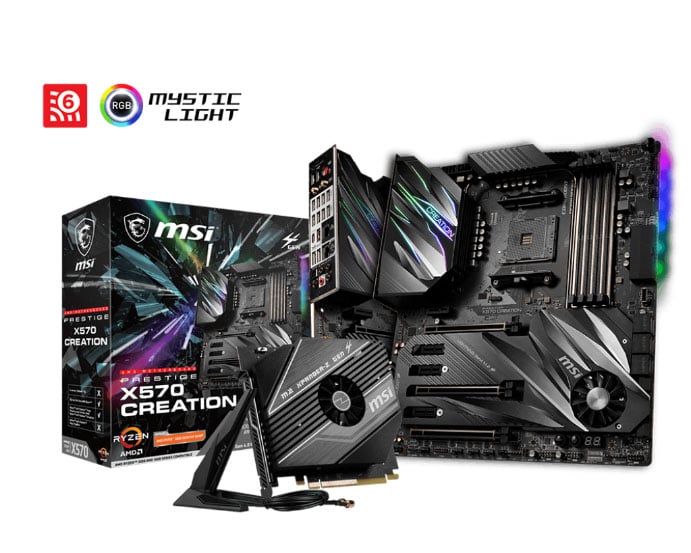
Image-Source: MSI
PCI-E x16 Slot Bandwidth Distribution (With all slots populated) – x8/x8/x4
Form Factor – E-ATX
Wi-Fi – Yes
BIOS Flashback (CPU-less BIOS Updates) – Yes
If you want an excellent motherboard that can easily handle 12 and even 16-core Ryzen CPUs with ease without compromising on any features, the MSI Prestige X570 CREATION hits the sweet spot.
Please note that this motherboard has an E-ATX form factor. Make sure that your PC cabinet supports it before going ahead with the purchase. Check the case’s technical specifications page to be sure.
Although the X570 CREATION has an extremely robust VRM design, it’s overkill unless you plan to do some extreme overclocking. Nonetheless, I consider this a bonus, if anything, because the motherboard doesn’t really compromise on features on offer.
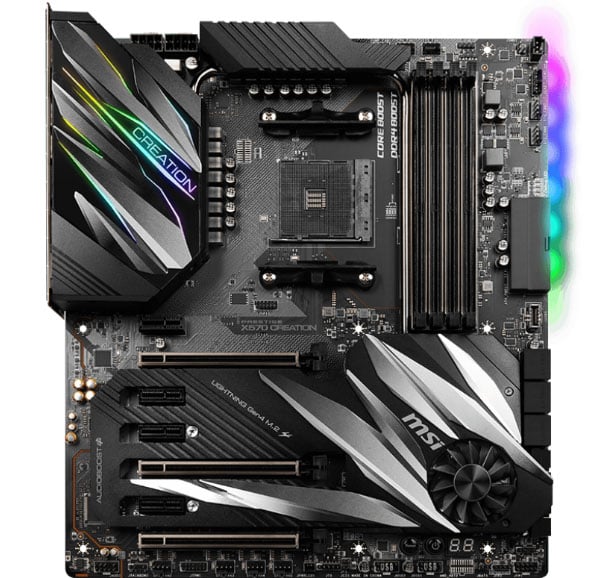
Image-Source: MSI
Dual 8-pin CPU power delivery sockets, beefy VRMs, an ample number of SATA, and M.2 slots.
An included M.2 Xpander Card for additional M.2 slots, server-grade PCB for better heat resistance, extensive QVL, numerous back-panel ports.
Built-in 10 GbE LAN, and Wi-Fi 6. These are the most prominent features on this board.
The CREATION’s QVL is astonishing. You should hit the 3600 MHz mark with a decent RAM kit, no problem – even when running quad-memory configurations.
You can find the QVL for the X570 CREATION here.
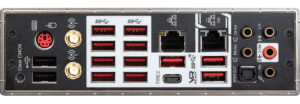
Image-Source: MSI
The back panel is heaven for those who love their USB ports. I sure do! With a whopping 14 USB ports, dual LAN ports, a clear CMOS button, and multiple audio ports, the CREATION knocks it out of the park when it comes to back-panel connectivity.
To be honest, at this price range, you can’t go wrong with any of the options available. However, the M.2 Xpander Card sets the CREATION apart from competing Gigabyte and ASUS products.
It allows you to make use of all the extra bandwidth that comes with PCI-E 4.0 without spending a penny more.
If you use a NAS (Network Attached Storage) device to transfer files in and out of workstation PCs for render tasks, the built-in 10 GbE LAN is a Godsend. Combining it with a 10 GbE network switch and a NAS device will reduce transfer times by up to 90% (compared to traditional 1 GbE LAN).
On the other hand, if you don’t need additional M.2 slots, access to built-in 10 GbE LAN, and the new Wi-Fi 6 standard, you should consider shopping at the sub-$400 pricing tier.
Note – If you only need additional M.2 slots, skip down a price tier and get a separate add-in card. You can save right around $100-140 (USD) this way.
Recommended for: Ryzen 9 only (5950X, 5900X, 3950X & 3900X). Unless you’re after one of the features unique to this motherboard, there’s no reason to grab the MSI Prestige X570 CREATION for Ryzen 7 CPUs.
Best X570 Motherboards for Ryzen 5000 CPUs (5950X and 5900X) under $400
ASUS ROG X570 Crosshair VIII Hero (ATX)
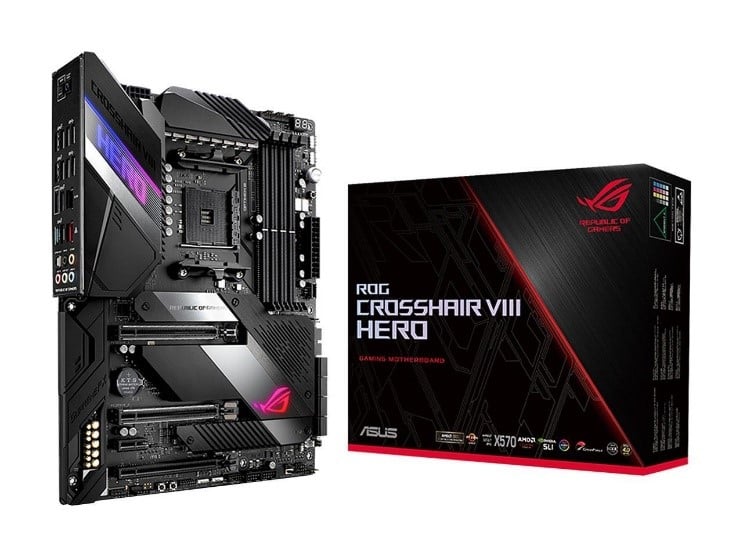
Image-Source: ASUS
PCI-E x16 Slot Bandwidth Distribution (With all slots populated) – x8/x8/x4
Form Factor – ATX
Wi-Fi – Yes
BIOS Flashback (CPU-less BIOS Updates) – Yes
If you’re going for an ATX form factor motherboard with a budget below $400, you can’t go wrong with the ASUS X570 Crosshair VIII Hero.
Note – There’s absolutely no reason to consider the pricier Crosshair VIII Formula, a motherboard that’s priced at a whopping $700 with little-to-no benefit for real users.
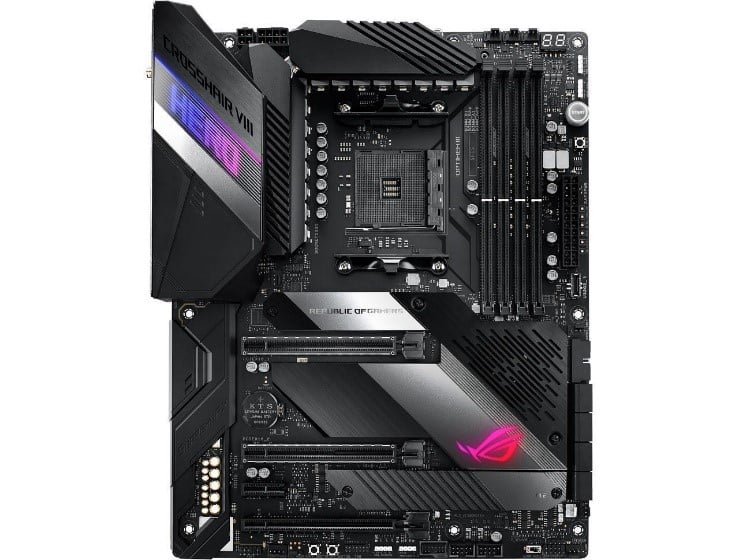
Image-Source: ASUS
Similar to other options in these relatively higher price tiers, the Hero’s VRMs are pretty overkill and robust. Not only can it handle the top-end parts from the 3rd Generation Ryzen like the 3900X, but it is also reliable enough to handle the upcoming 16-core monster (Ryzen 9 3950X) as well.
The dual LAN (Realtek and Intel) gives you the much-needed flexibility to go with the brand you prefer.
Some swear by Intel LAN and will scoff at anything or anyone that says Realtek, mostly due to experience. There’s a built-in Wi-Fi 6 version of this board as well – for those who need the latest standard in wireless connectivity.
The ASUS ROG X570 Crosshair VIII Hero comes equipped with a whopping 8 SATA ports and dual M.2 slots – giving most users ample peripheral connectivity options.
It also features 3 full-size PCI-E slots (x16/x8) that could be used to add functionality like M.2 Expander cards or run 3-way SLI or Crossfire configurations.
Memory support is first-rate on ASUS motherboards like the X570 Hero. You can find the QVL list here. The list of RAM sticks running successfully on 3600 MHz and above is pretty impressive.
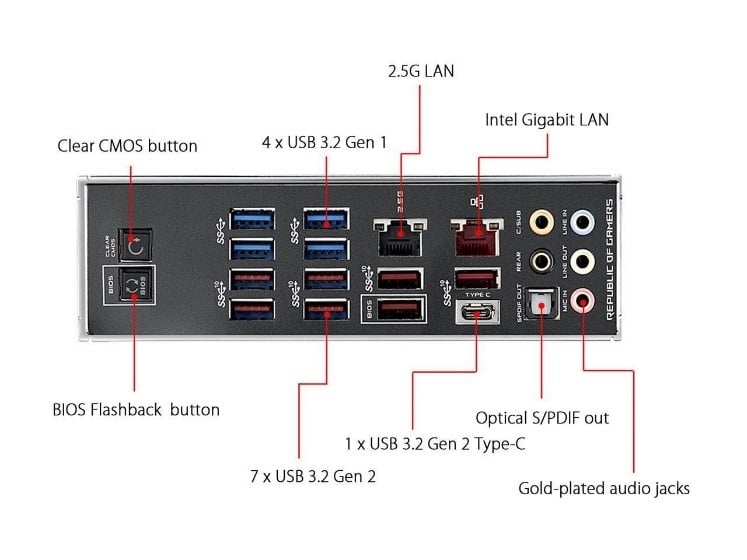
Image-Source: ASUS
In addition to being very internal peripheral-friendly, the Hero has extensive back-panel connectivity with 12 USB ports, gold-plated audio jacks, and dual-LAN ports.
The back panel also features a Clear CMOS button as well as a BIOS flashback button for flashing your BIOS even if you don’t have a CPU installed.
Recommended for Ryzen 9 only (5950X/5900X). If you can’t fit an E-ATX motherboard into your case, the Crosshair VIII Hero is a great choice that doesn’t compromise on much.
ASUS Pro WS X570 Ace – Best Motherboard for Ryzen 5000 (5950X, 5900X, and 5800X) with PCI-E Bifurcation (x8/x8)
PCI-E x16 Slot Bandwidth Distribution (With all slots populated) – x8/x8/x8
Form Factor – ATX
Wi-Fi – No
BIOS Flashback (CPU-less BIOS Updates) – No
ASUS’ Pro WS lineup is well-known for delivering workstation-class motherboards even on mainstream platforms. That hasn’t changed with their X570 variant for Ryzen processors. The ASUS Pro WS X570 Ace’s VRMs are robust, offering a 12+2 phase power delivery – ensuring that it can easily handle even the Ryzen 9 5950X 16-core CPU.
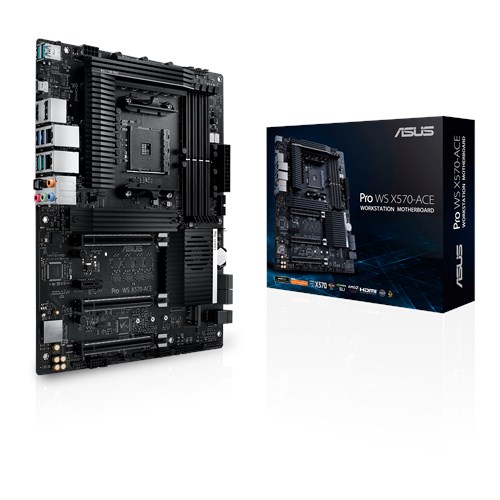
Image-Source: ASUS
Another unique aspect is the availability of triple full-size PCI-E slots (running at x8/x8/x8). Although other X570 motherboards do have three slots, this is one of the few that gives you three that run using 8 PCI-E 4.0 lanes.
The motherboard also has a decent QVL, so memory clocks and tuning shouldn’t be an issue with most memory kits in the market.
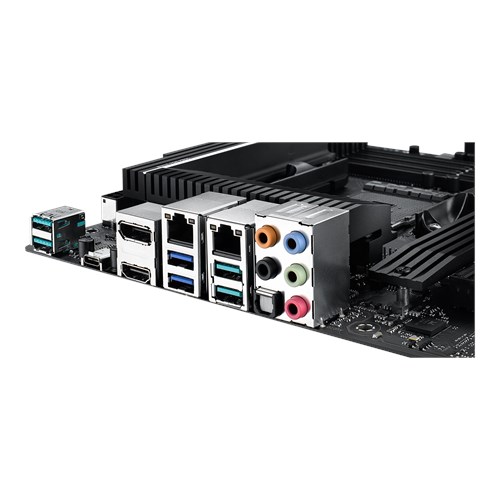
Image-Source: ASUS
The motherboard’s back panel is decent, offering 7 USB ports (1x Type-C and 6x Type-A). What’s more, 5 out of those 7 USB ports support the latest USB standard – granting access to 10 Gbps data transfer capabilities. It does come with dual LAN: 2.5 GbE Intel and 1 GbE Realtek. However, if you’re looking for 10G LAN or Wi-Fi 6, this isn’t the right motherboard.
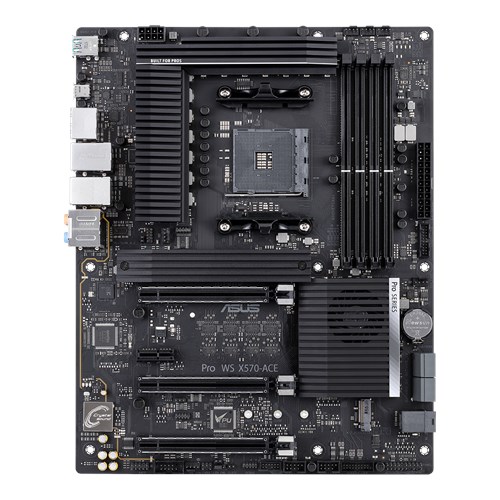
Image-Source: ASUS
NVMe support is excellent as well, and the Pro WS X570 offers 2x M.2 slots (PCI-E 3.0 x4 and PCI-E 4.0 x2). You might run into issues when populating both M.2 slots in some cases. If you’re using professional-grade PCI-E 3.0 NVMe drives, you’d be only able to use x2 PCI-E 3.0 lanes on the second M.2 slot – leaving you shortchanged for speed. Do remember, this only applies if you’re doing a lot of sequential read/writes on that second drive. Also, you do have the option of a U.2 SSD that runs at PCI-E 3.0 x4.
Recommended for: Ryzen 9 (5900X and 5950X) and lower if you don’t need a lot of CPU power and require additional GPU horsepower.
Best X570 Motherboards for Ryzen 5000 CPUs (5950X, 5900X, and 5800X) around $300
ASRock X570 Taichi (ATX) – Overall Best Value Motherboard with PCI-E Bifurcation (x8/x8)
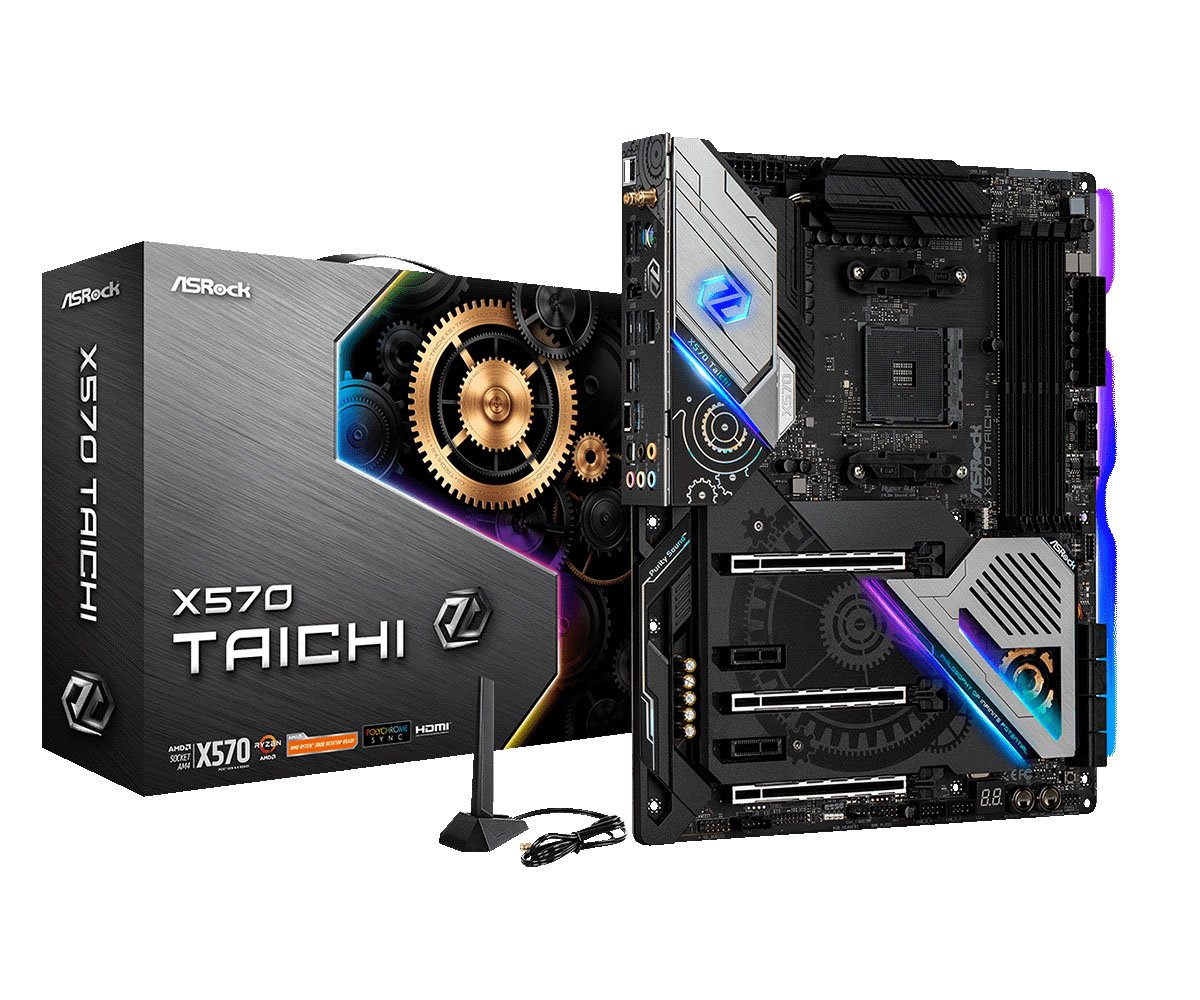
Image-Source: ASRock
PCI-E x16 Slot Bandwidth Distribution (With all slots populated) – x8/x8/x4
Form Factor – ATX
Wi-Fi – Yes
BIOS Flashback (CPU-less BIOS Updates) – Yes
The value offered by the ASRock X570 Taichi is undeniable. It is considered one of the best motherboards out there for both Ryzen 9 and Ryzen 7 processors, with good reason.
Even though it’s priced much lower, it comes with many of the bells and whistles that you usually see on high-end motherboards. Granted, we ARE still talking about a $300 motherboard here.
The ‘lower’ price does come with some caveats, though.
Not only do you lose access to 2.5 GbE LAN and dual LAN, but you also lose a good bit of memory support, especially for quad-memory configurations. Compared to other motherboards in its weight class, the Taichi’s QVL is quite sparse.
Nonetheless, for most users who aren’t planning on overclocking memory past 3733 MHz (you shouldn’t on AMD), it should be just fine!
For everything else, the Taichi offers immense value at its price point.
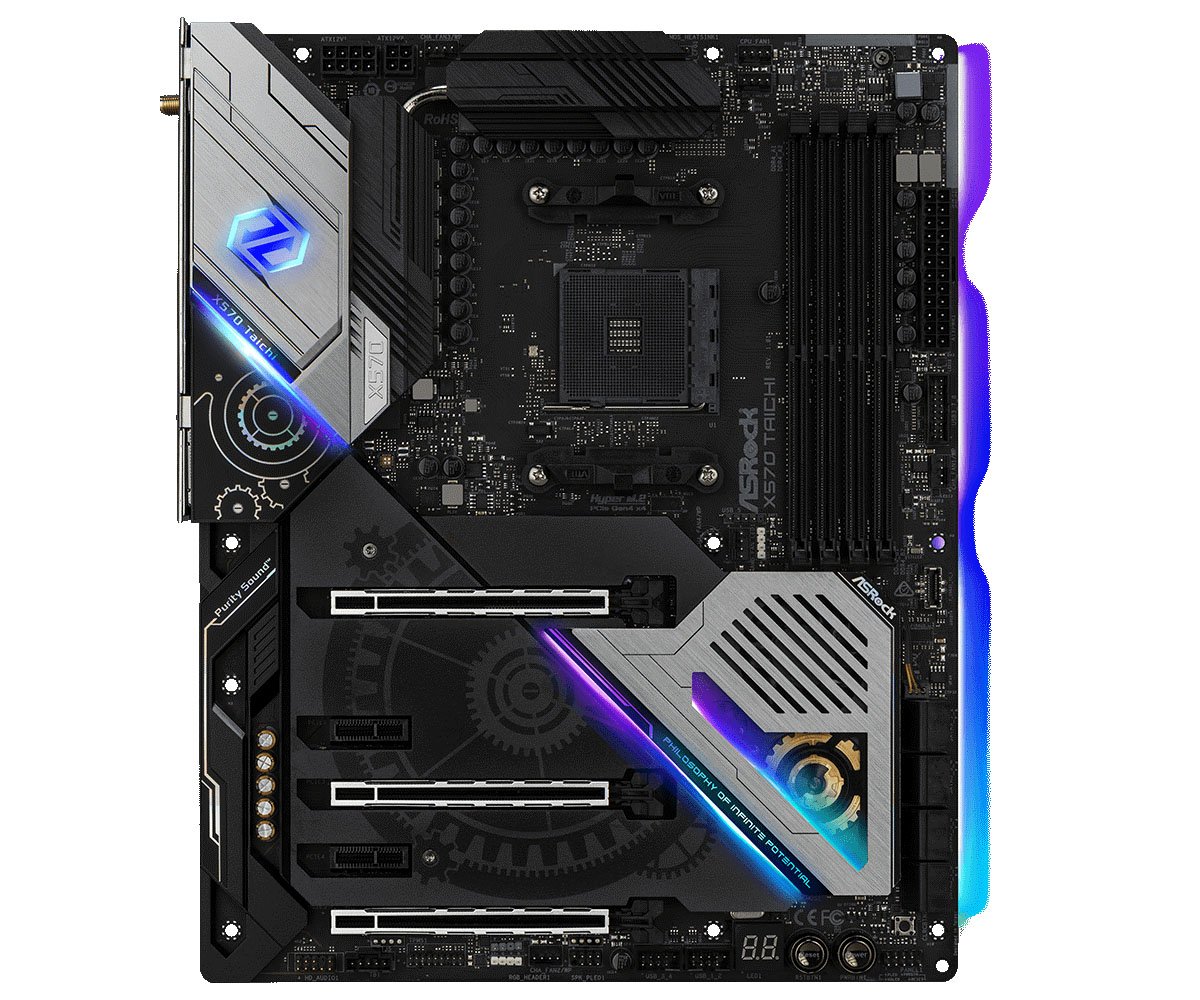
Image-Source: ASRock
The ASRock X570 Taichi comes equipped with a beefy VRM, one that goes toe-to-toe with even its pricier X570 counterparts.
Hence, it is capable of handling the most powerful processors that AMD has to offer – the 5950X, 5900X, and 5800X.
Although the Taichi doesn’t come with dual LAN capabilities, it features the preferred Intel Gigabit LAN instead of Realtek.
Funnily, it also comes equipped with 2.4 Gbps Intel Wi-Fi 6, making the wireless adapter much faster (2.4 times) than the Ethernet LAN on this motherboard.
Now, when it comes to peripheral connectivity, this motherboard doesn’t compromise. It comes with 8 SATA ports, 3 M.2 ports, 2 PCI-E x1 slots, and 3 full-size PCI-E x16 slots.
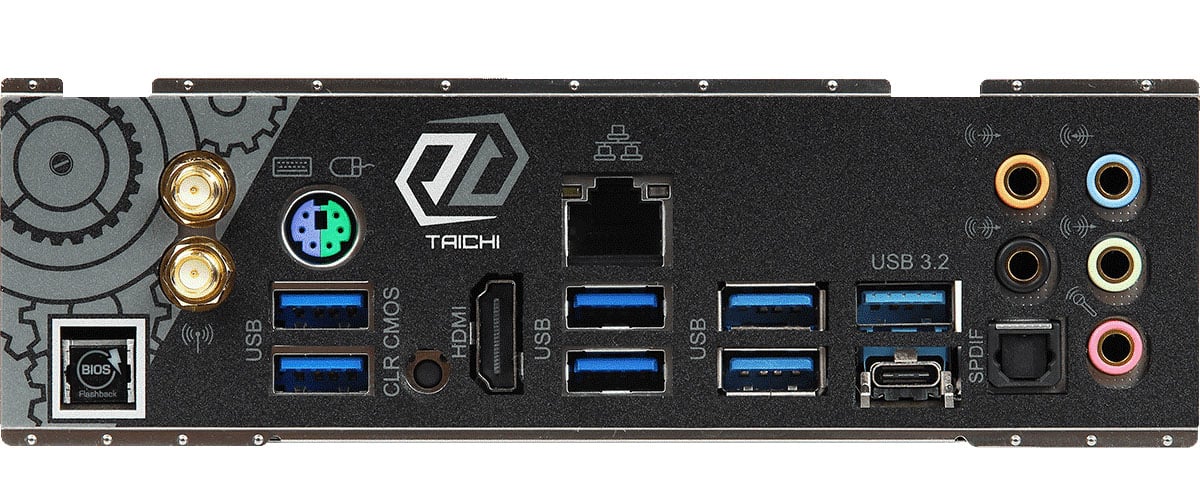
Image-Source: ASRock
It doesn’t skimp out too much when considering back-panel connectivity, either. It features an array of audio ports, 7 USB ports, Gigabit LAN port, a clear BIOS button, and two wireless antennae.
Recommended for: Ryzen 9 and 7 (5950X, 5900X, 5800X).
Priced at just under $300, the Taichi offers fantastic value. If you don’t see anything specific in higher-priced motherboards that you really must have, go for the Taichi.
Best Motherboard for Ryzen 5000 (5900X, 5800X, and 5600X) under $200
Gigabyte X570 Aorus Elite (ATX)
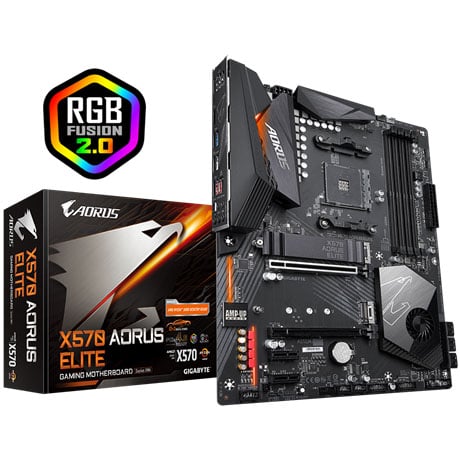
Image-Source: Gigabyte
PCI-E x16 Slot Bandwidth Distribution (With all slots populated) – x16/x4
Form Factor – ATX
Wi-Fi – No
BIOS Flashback (CPU-less BIOS Updates) – No
Gigabyte’s $200 offering features PCI-E 4 capabilities at a much lower price point while retaining quality VRMs.
So, it’s a splendid option for those on a budget. The X570 Aorus Elite packs enough power to run the 5900X, 5800X, and the 5600X easily – allowing them to boost as high as they possibly can.
The Aorus Elite also features Intel Gigabit LAN, much like its pricier X570 counterparts.
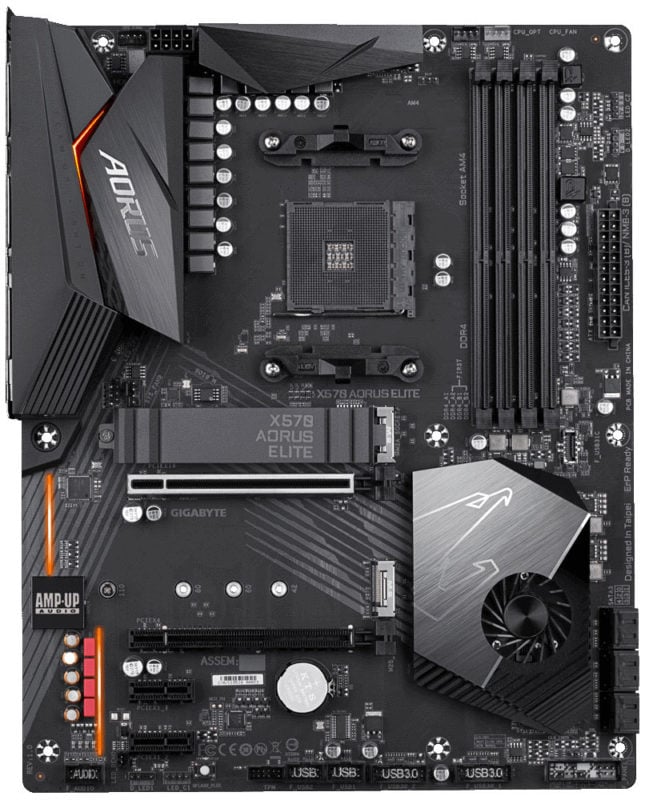
Image-Source: Gigabyte
Expansion presents the first real limitation of the Gigabyte X570 Aorus Ultra when compared to other motherboards. It features 2 full-size (x8/16) PCI-E slots, 2 PCI-E x1 slots, 2 M.2 slots, and 6 SATA ports.
Memory support is pretty terrific on all Gigabyte motherboards, and the Aorus Elite is no exception. Whether you’re running dual or quad-memory configurations, you should be able to get to 3600 MHz with relative ease.
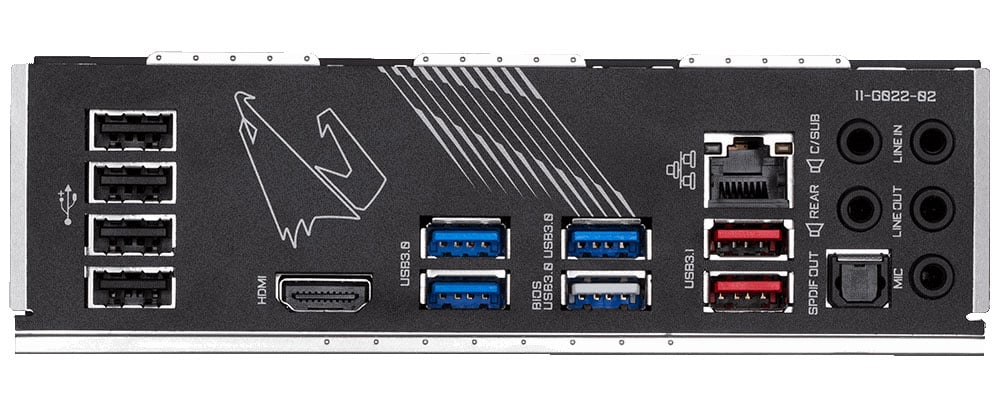
Image-Source: Gigabyte
The back panel of the Gigabyte X570 Aorus Elite is pretty great as well.
It comes with an array of 10 USB ports, audio ports, Ethernet port, and an HDMI port for AMD APUs (I don’t recommend pairing one with this board though). The absence of a ‘clear CMOS’ button is pretty conspicuous, though. Oh well.
Recommended for: Ryzen 9, 7, and 5 (5900X and all the way down to the 5600X).
Perfect for those who want the most on a budget, especially if you’re going with an AMD Ryzen 9 3900X.
Alternative to Aorus Elite: Asus TUF X570 Gaming
In case the Gigabyte Aorus Elite is out of stock, has an inflated price, or is just not available in your country, you should consider the Asus X570 TUF Gaming as an excellent alternative.
PCI-E x16 Slot Bandwidth Distribution (With all slots populated) – x16/x4
Form Factor – ATX
Wi-Fi – No (There’s a Wi-Fi Variant for an additional $10)
Best Budget B450 Motherboards for Ryzen 7 and Ryzen 5
If you’re on a relatively tight budget or don’t plan to upgrade past an 8-core Ryzen 3000 processor in the near future, B450 motherboards continue to offer insane value.
Since 3rd Generation Ryzen launched quite a while ago, most BIOS issues have been ironed out, and what’s more, almost all motherboards will support 3rd Generation Ryzen CPUs out of the box.
However, if you need a budget motherboard for Ryzen 5000 CPUs, I’d recommend checking out B550 motherboard options.
When shopping in this price tier, VRM thermals do become a problem when you’re building a PC for extended render workloads. A few B450 boards will outright fail when running render tasks, so make sure that you’re not compromising on performance and quality for looks and marketing.
We found the following B450 Motherboards, though, to be reasonably good picks that can take the stress of an intensive workload:
MSI B450 Tomahawk MAX
PCI-E x16 Slot Bandwidth Distribution (With all slots populated) – x16/x4
Form Factor – ATX
Wi-Fi – No
BIOS Flashback (CPU-less BIOS Updates) – Yes
The Tomahawk was one of the most popular motherboards for 2nd Generation Ryzen, with good reason.
The Tomahawk MAX retains the same designs and specs and bumps the BIOS chip to accommodate support for AMD’s full CPU lineup without sacrificing MSI’s Click BIOS. Even now, this is the Best B450 Motherboard for Ryzen processors by a healthy margin.
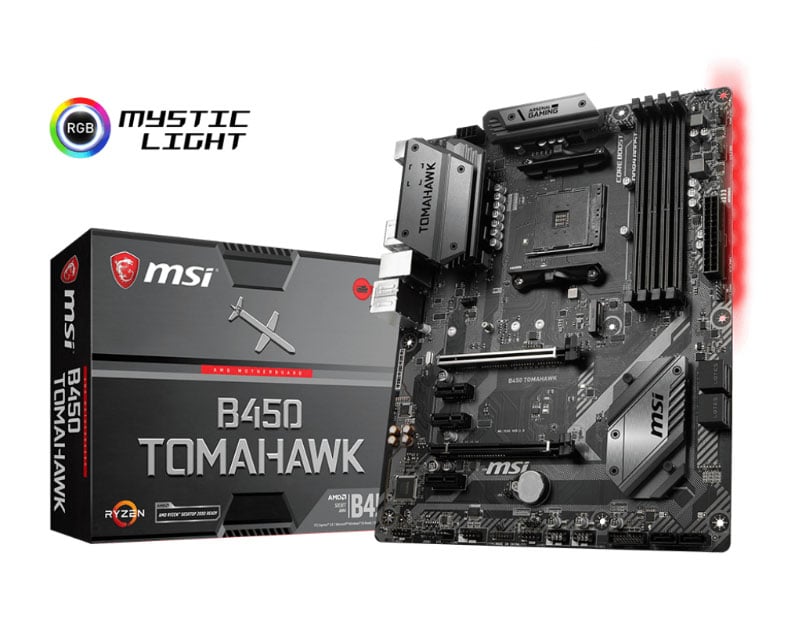
Image-Source: MSI
VRM Quality – Extended Render Performance
The MSI Tomahawk MAX continues to offer high-quality hardware at an attractive price point, along with premium features like BIOS Flashback.
MSI’s use of surprisingly sturdy VRMs that can handle even a 12-core Ryzen without holding it back at all is quite impressive indeed. However, I’d still recommend limiting the use of this motherboard to an 8-core Ryzen when we’re talking about extended workloads like rendering.
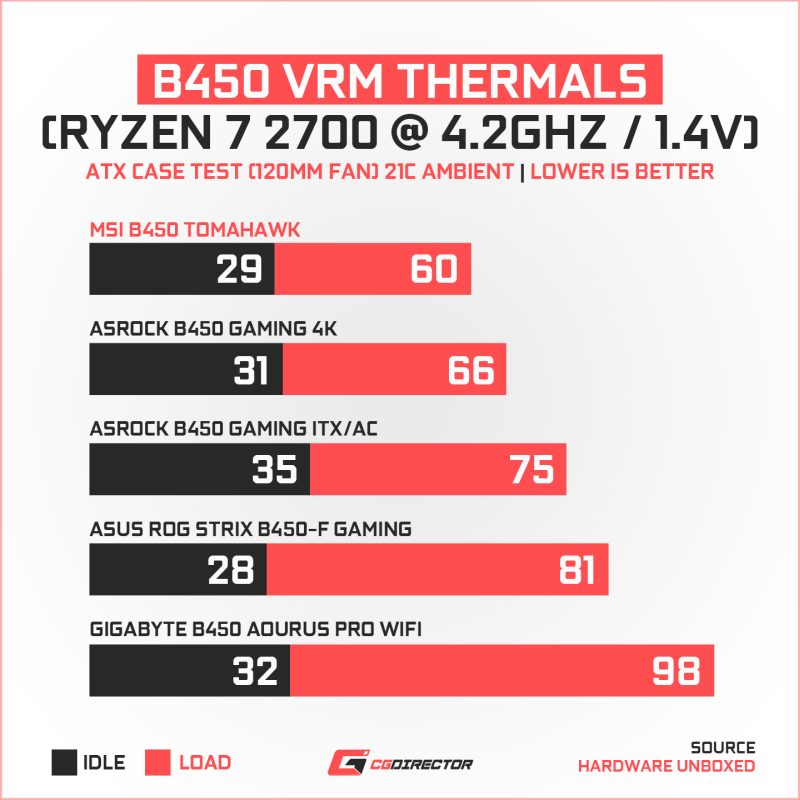
Testing by Hardware Unboxed
Memory – QVL and Overclocking
Moreover, MSI’s excellent memory support does carry over to their B450 motherboards and the Tomahawk should be able to handle a broad range of memory kits.
The QVL for the Tomahawk is nothing short of impressive, featuring a good number of memory modules running in even quad-channel configurations at speeds well above the standard 3200 MHz mark.
You can find the QVL here.
Slot Layout – PCI-E and Storage
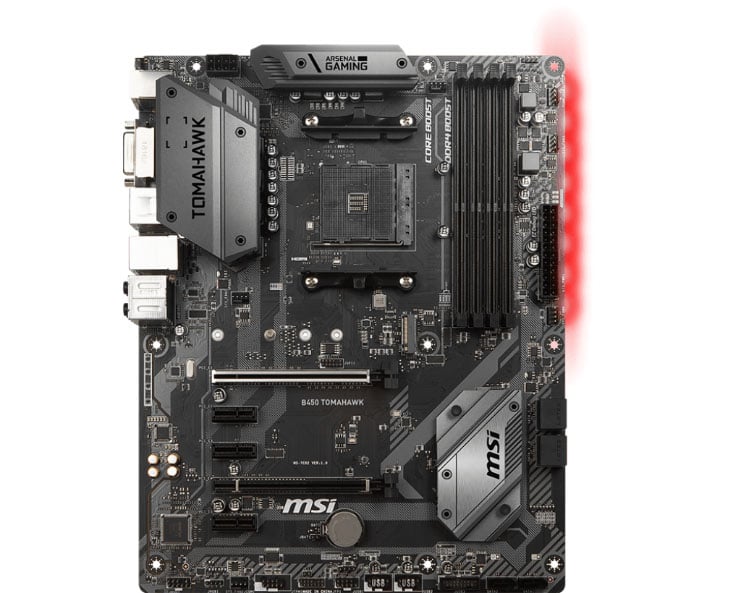
Image-Source: MSI
The B450 Tomahawk comes equipped with 2 full-length PCI-E (x16 and x4) slots, 3 PCI-E x1 slots, 6 SATA ports, and a single M.2 slot. The single M.2 might be a bummer, but you can get around the limitation with a PCI-E add-in card.
Rear-Panel I/O
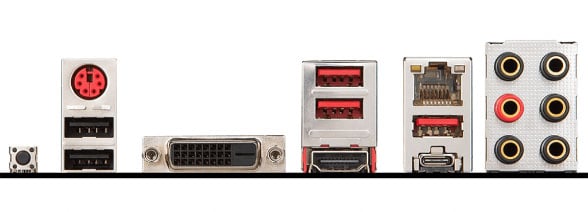
Image-Source: MSI
When it comes to back-panel connectivity, the Tomahawk isn’t trailing too far behind its bigger, pricier brethren. It features 6 USB ports (5 Type-A and 1 Type-C), a DVI port and an HDMI port for AMD APUs with integrated graphics, an Ethernet port, and audio ports.
Recommended for: Ryzen 7 and 5. A great motherboard overall, considering the value it brings.
ASRock B450 Gaming K4 (ATX)
PCI-E x16 Slot Bandwidth Distribution (With all slots populated) – x16/x4
Form Factor – ATX
Wi-Fi – No
BIOS Flashback (CPU-less BIOS Updates) – No
Although MSI’s B450 Tomahawk Max is the best B450 motherboard by a good margin, ASRock’s Fatal1ty B450 Gaming K4 is an excellent alternative if you’re unable to find the former in your region.
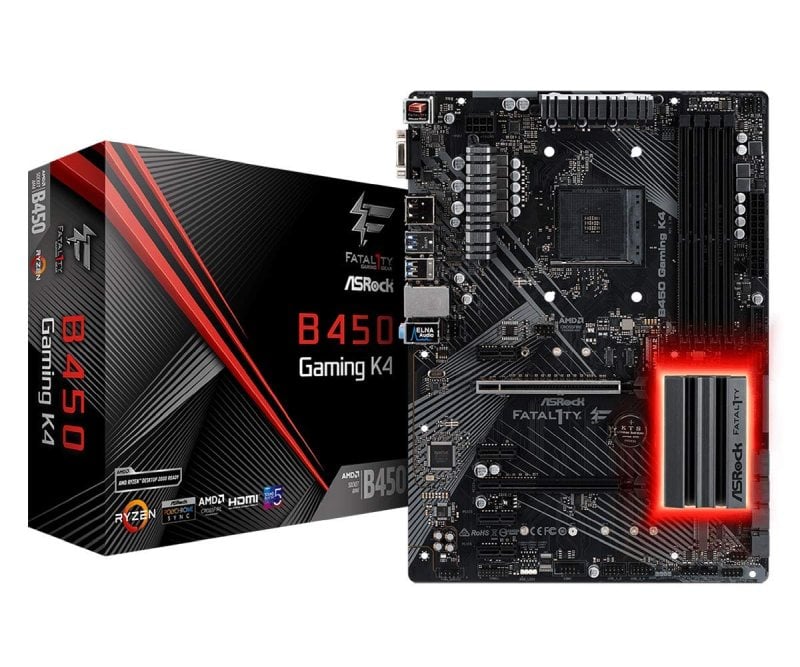
Image-Source: ASRock
VRM Quality – Extended Render Performance
With even minimal airflow, the Gaming K4’s VRMs hold up pretty well with an 8-core Ryzen. Even in stress tests and extended render workloads, the motherboard never even came close to failing, and its VRM temperatures remained well within safe limits.
Memory – Overclocking and QVL
As we’ve come to expect, ASRock’s QVL for the Gaming K4 is relatively sparse. In my testing, though, most memory kits do work at their rated speeds as long as you’re going with something within 3600 MHz paired with a 3rd Generation Ryzen processor.
Nonetheless, I still recommend checking for memory kits that are listed on the QVL.
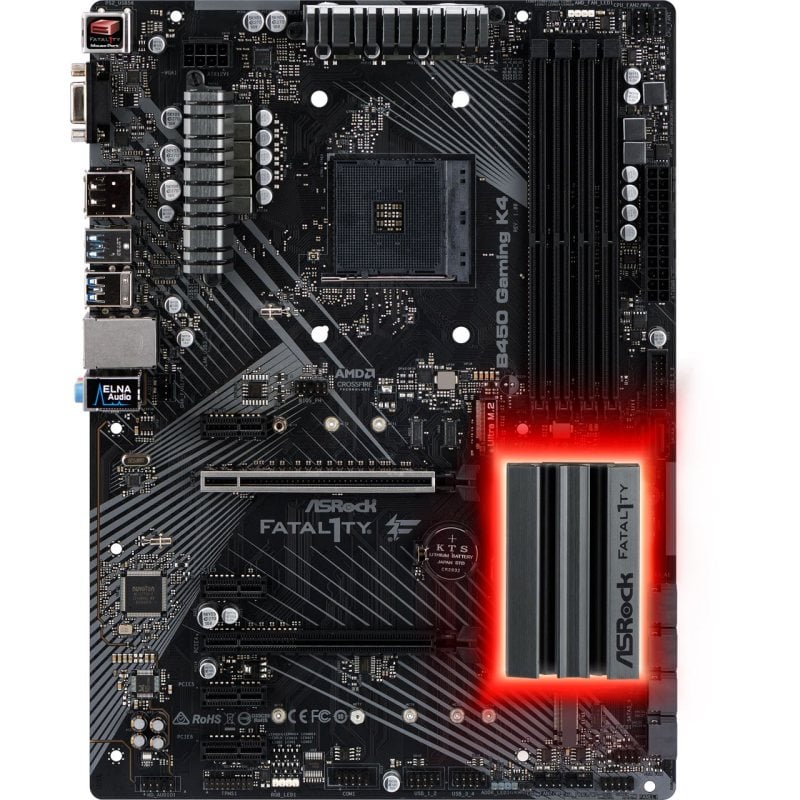
Image-Source: ASRock
Slot Layout
The Gaming K4’s slot layout is quite similar to other B450 motherboards, and there’s nothing out of the ordinary here. There are two full-length PCI-E 3.0 slots (running at x16 and x4, respectively). There are 4 PCI-E 2.0 x1 slots for various expansion cards.
Unlike a few other B450 boards, including the B450 Tomahawk, ASRock has equipped the Gaming K4 with two M.2 slots. However, keep in mind that populating the M.2 slots will disable the second full-length PCI-E slot as well as 2 out of 6 SATA connectors on the motherboard.
Rear-Panel I/O: Lots of USB Ports
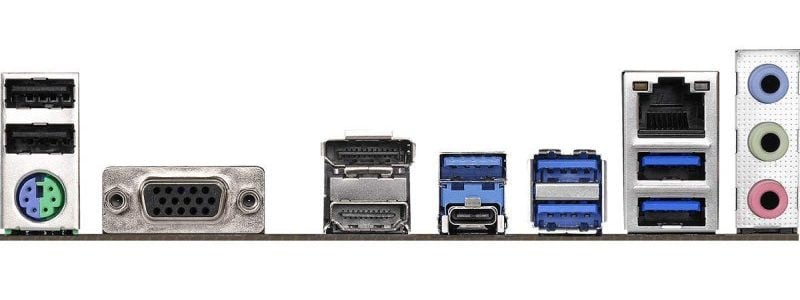
Image-Source: ASRock
The Gaming K4 has an impressive rear-panel I/O port selection, rivaling even some X570 motherboards. If you’re on the lookout for a lot of USB ports, including a Type-C USB, this is a great choice.
Recommended for: Ryzen 7 and 5 only.
Note: This is one of the few motherboards that supports a triple monitor setup when using an AMD APU with an iGPU like the 3200G.
ASRock Fatal1ty B450 Gaming ITX/ac (ITX)
PCI-E x16 Slot Bandwidth Distribution (With all slots populated) – x16
Form Factor – ATX
Wi-Fi – Yes
BIOS Flashback (CPU-less BIOS Updates) – No
If you’re going for a compact build, the ASRock B450 Gaming ITX/ac is one of the best motherboards that can handle even 8-core processors without affecting performance, even with extended workloads like rendering.
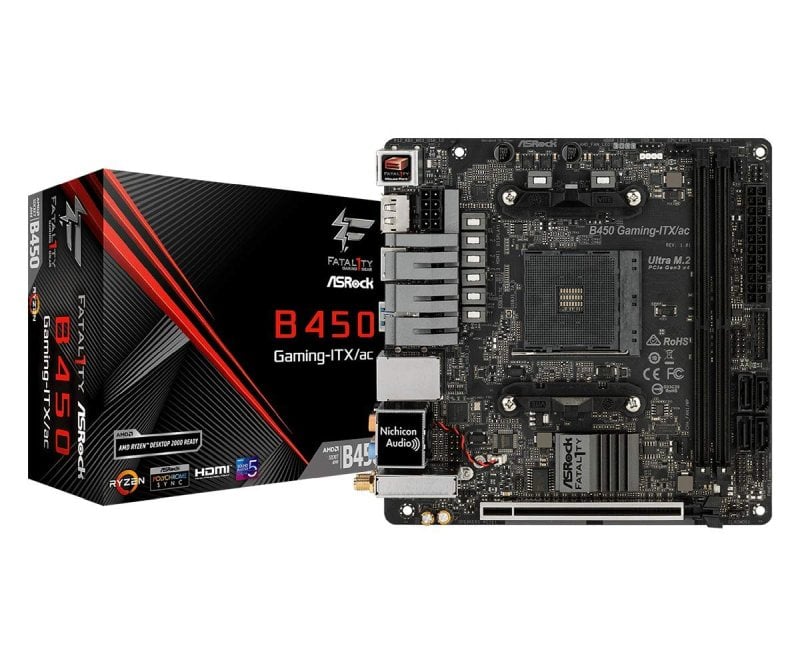
Image-Source: ASRock
VRM Quality – Extended Render Performance
Even with minimal airflow, the Gaming ITX/ac’s VRMs don’t overheat in the slightest. Most compact ITX PC builds will have airflow issues, which makes this an especially important factor for those who want to go with a relatively smaller form-factor workstation PC.
Memory – QVL and Overclocking
For some reason, the 3rd Generation Ryzen’s QVL for this motherboard is missing on ASRock’s official website. However, even if we assume it’s similar to the B450 Gaming K4, it won’t be overly promising. Official memory support pegs the memory to work at “DDR4 3466+”.
Personally, I’d just avoid any higher clocked memory kits (3200+) unless you can find it on the general QVL.
Slot Layout – Extensibility and Convenience
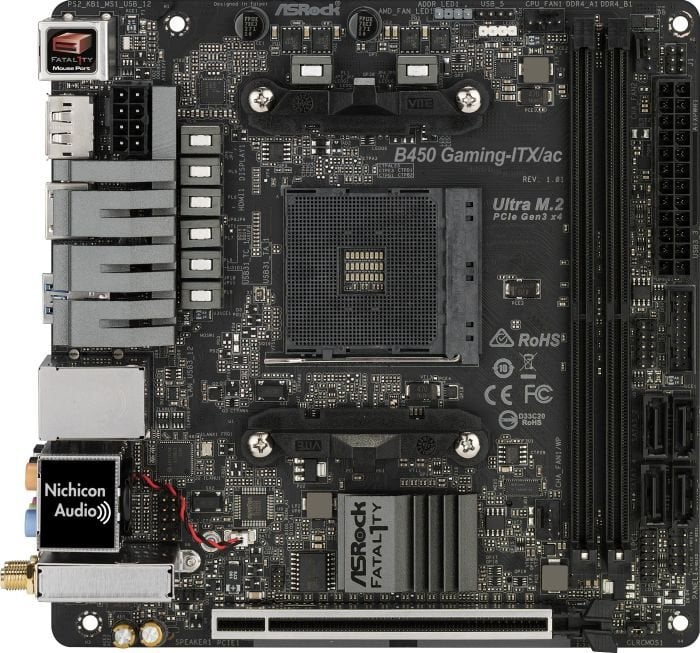
Image-Source: ASRock
As with many ITX motherboards, the ASRock Gaming ITX/ac has a standard slot layout. It features a single full-length PCI-E slot (x16) and does support riser cards if you’d like to extend that slot to 2 PCI-E slots (x8 and x8).
The Gaming ITX/ac motherboard has a single vertical M.2 slot. Moreover, it also features Wi-Fi and Bluetooth.
Rear-Panel I/O – USB, Wi-Fi Antenna, Audio, LAN
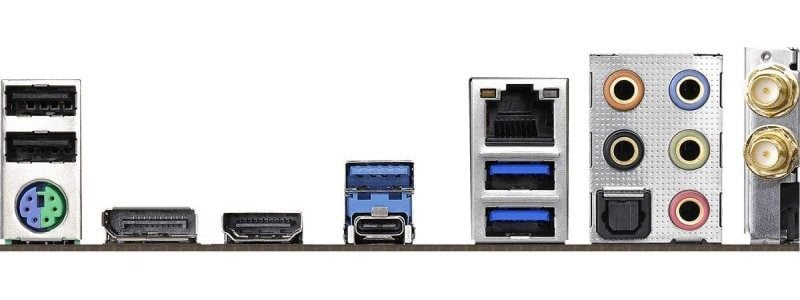
Image-Source: ASRock
When you’re opting for a smaller form factor like ITX, you do give up some port selection on the back. However, the Gaming ITX/ac motherboard doesn’t give up too much with respect to the back-panel ports. There are 5 USB Type-A ports and even a single Type-C port.
Recommended for: Ryzen 7 and 5 only.
Addressing Some Common Concerns
Q: I’m already on an X470/B450/X370/B350/A320 motherboard, and I don’t need PCI-E 4.0. Should I still switch to a new X570 or B550 motherboard?
A: It depends. If you’re upgrading to the 5800X or 5600X, no need to upgrade as long as you’re on a 400-series motherboard. Do make sure that your motherboard manufacturer has an updated BIOS with support for Ryzen 5000 CPUs available on their website.
On the other hand, if you’re upgrading to a Ryzen 9 CPU like the 5900X/5950X and you’re not on an X470 motherboard, then I recommend upgrading to get the most performance out of it.
For those wanting to upgrade up to 3rd Generation Ryzen 5 CPUs on a budget, even older B350/A320 motherboards should be enough.
Q: Will I need a BIOS update if I want to pair an older motherboard with Ryzen 5000 processors?
A: Yes. You’ll need an older Ryzen CPU to update BIOS once if you don’t grab a motherboard with features like BIOS Flashback – allowing you to update firmware without installing a CPU. If you don’t have access to either of those things, don’t worry.
AMD’s running a boot kit program for those with this exact issue. You can find out more about this program here: https://www.amd.com/en/support/kb/faq/pa-100#faq-Short-Term-Processor-Loan-Boot-Kit
Q: I’m buying a new motherboard and a 3rd Generation Ryzen 9/7 CPU. Should I buy an X470 motherboard if I don’t need PCI-E 4.0?
A: You could, but I don’t recommend it. The prices of any good X470 motherboards come pretty close to or even exceed some X570 motherboards available right now. For a Ryzen 7 CPU, you could stick to a good B450 motherboard like the MSI B450 Tomahawk.
Q: I see fans on the new X570 motherboards. Will they be noisy? Can I get an X570 motherboard with passive cooling instead of active cooling?
A: No, they are surprisingly silent most of the time. In fact, during most of my tests, the fans barely even spun up. Unless you’re stretching the limits of the board by beginning to saturate all that PCI-E 4.0 bandwidth, I don’t expect the fans to spin much at all.
Yes, there is precisely one X570 motherboard with passive cooling – the $700 Gigabyte X570 Aorus Extreme.
That’s a steep price just to get rid of fans. If you’re still opposed to the fans, and you’re grabbing either an AMD Ryzen 3800X, 3700X, 3600, or 3600X, you could make do with an older B450 motherboard.
Q: I see some manufacturers like Biostar enabled PCI-E 4.0 on older motherboards. Can I get those older motherboards to get PCI-E 4.0 on the cheap?
A: Although Biostar did enable PCI-E 4.0 with a BIOS update, it might be short-lived.
Firstly, I didn’t find any data about whether those motherboards can indeed handle full PCI-E 4.0 bandwidth without compromising stability.
Secondly, AMD might disable it with the next AGESA update, like they did when ASUS enabled PCI-E 4.0 support on older motherboards.
Of course, you could choose to stay on present firmware forever, but you’ll probably miss out on future efficiency improvements and other security updates.
Q: Why exactly shouldn’t I consider the quality of built-in audio on motherboards?
A: Well, there are a few reasons for this. The onboard audio capabilities of modern motherboards have come a long way.
So, for most users, every modern motherboard will offer an almost indistinguishable audio experience.
If audio is a significant factor for you, and the onboard option just isn’t cutting it, getting a separate add-in sound card is a much better option.
What’s more, it’ll work out cheaper and give you more flexibility with your purchase to boot. Here’s a Creative Sound Blaster sound card that should power even studio-grade, high-impedance headphones just fine.
Q: Will these motherboards work with the Ryzen 9 3950X as well/ Best motherboards for Ryzen 9 3950X CPUs?
A: All the listed boards CAN run the Ryzen 9 3950X, no problem. However, for extended render loads, I’d recommend shopping in and around the $300 price region. My value recommendations for professionals are the ASUS Pro WS X570 Ace and the MSI X570 Unify.
Q: Will these motherboards work with future Ryzen processor releases on the AM4 (Zen 3 and onwards)? / Will B450 motherboards support Ryzen 4000 CPUs?
A: While AMD has confirmed that the X570 motherboard lineup (and B550 when it finally launches) will support the Ryzen 4000 series desktop CPUs, the motherboards with B450 chipsets seem to have been left hung out to dry. Now, this can change, and AMD might backtrack on this plan. However, if you do plan on upgrading to the next generation of Ryzen processors, I recommend grabbing an X570 motherboard or wait for the B550 motherboards to launch.
You can find the full announcement here on AMD’s community website.
Update: AMD has backtracked on this announcement and left it to the motherboard manufacturers to decide whether to support Ryzen 4000 processors or not.
Want to compare AMD’s Platform offerings with Intel’s? Check our Motherboard Article for Intel CPUs here.
That’s about it! What Motherboard and PC-Build are you buying? Feel free to ask for help in the comments!
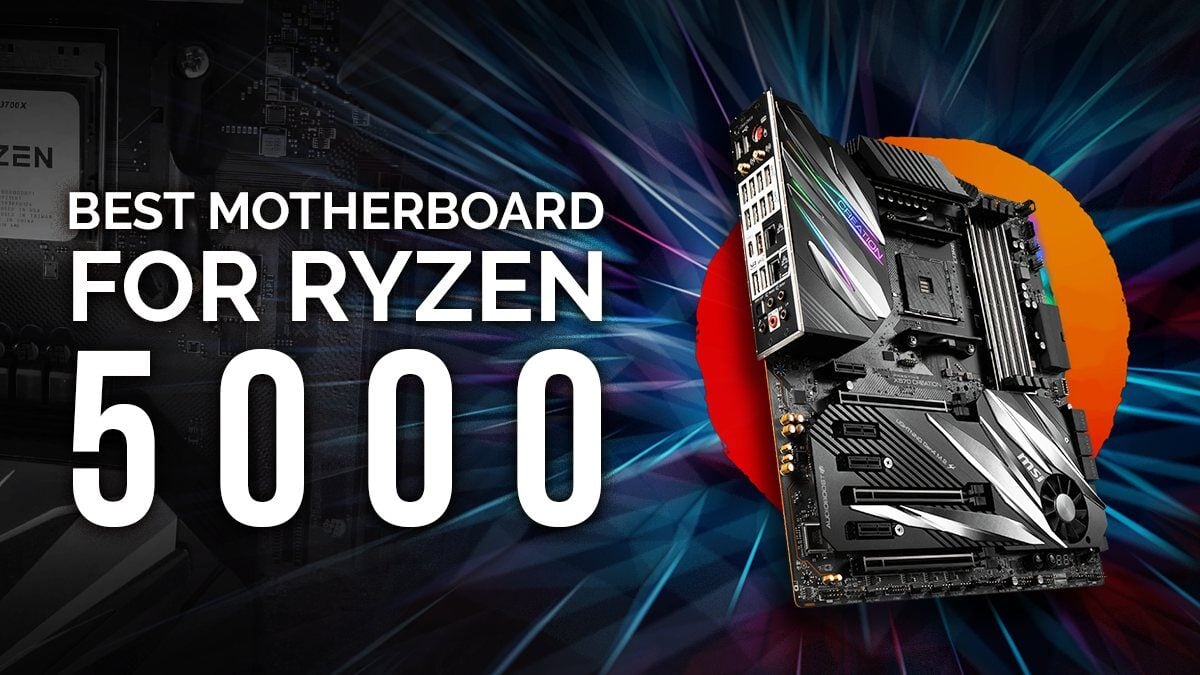
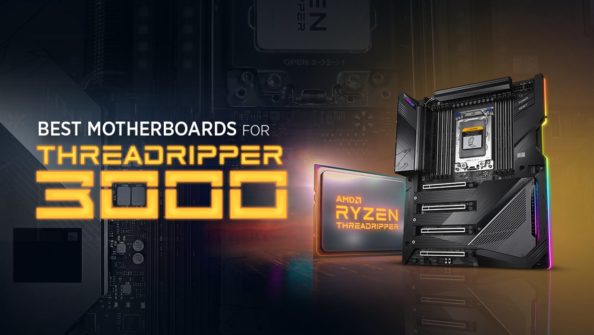
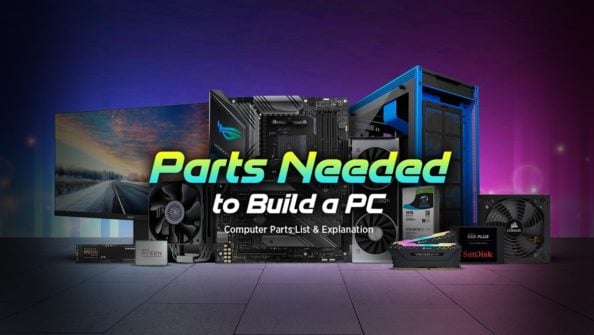
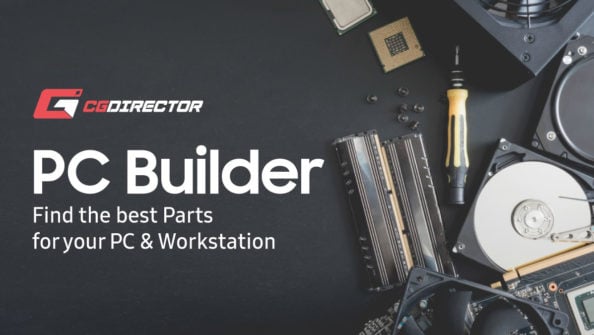
![Best CPU for Video Encoding [2024 Update] Best CPU for Video Encoding [2024 Update]](https://www.cgdirector.com/wp-content/uploads/media/2022/02/Best-CPU-For-Video-Encoding-Twitter-594x335.jpg)

274 Comments
24 September, 2022
The Asus WS X570-ACE does NOT have a PLX chip.
24 September, 2022
Hey Bob,
Yep, the third slot seems to be going through the chipset.
Fixed!
Thanks!
Jerry J.
25 May, 2022
How about MSI MAG X570 TOMAHAWK WIFI ?
25 May, 2022
Great board as well!
Cheers!
Jerry
8 March, 2022
How about the Gigabyte X570S AERO G ? I think it’s 8x 8x 4x which isn’t ideal but it’s a good price at the moment. Cheers.
8 March, 2022
Hey Andre, definitely a good board.
I guess it’s time to update this article with a couple of new X570S options in the market now 🙂 thanks for the heads up!
Cheers!
Jerry
8 March, 2022
Thanks Jerry. Appreciate the quick reply and this amazing article. Cheers
22 October, 2021
As always, such a helpful article.
Looks like MSI Prestige X570 CREATION is no longer available, any ideas as to what MB is the replacement/equivalent?
Thanks
22 October, 2021
Hey Philip,
I’d probably lean towards the Gigabyte X570 Aorus Master or the ASUS X570 Crosshair VIII Dark Hero 🙂
For a proper workstation (that might need multiple GPUs), my go-to recommendation is usually the ASUS Pro WS X570 Ace.
Cheers!
Jerry